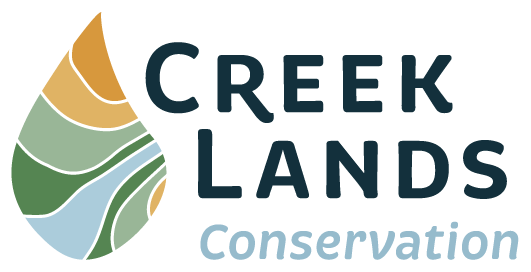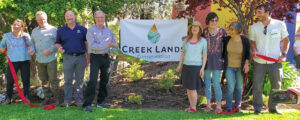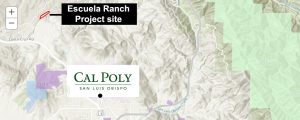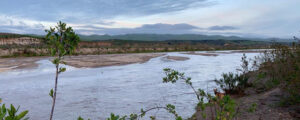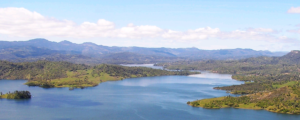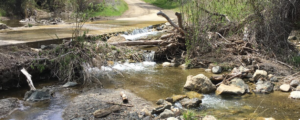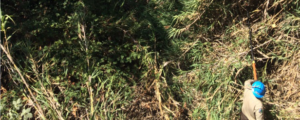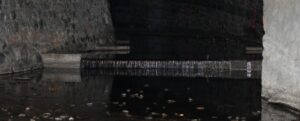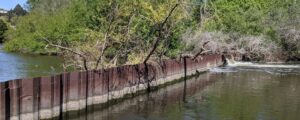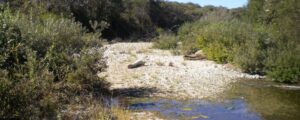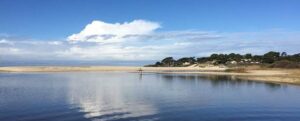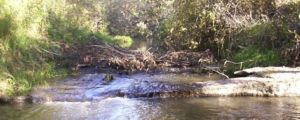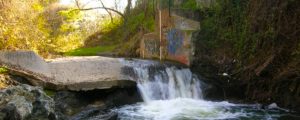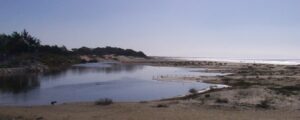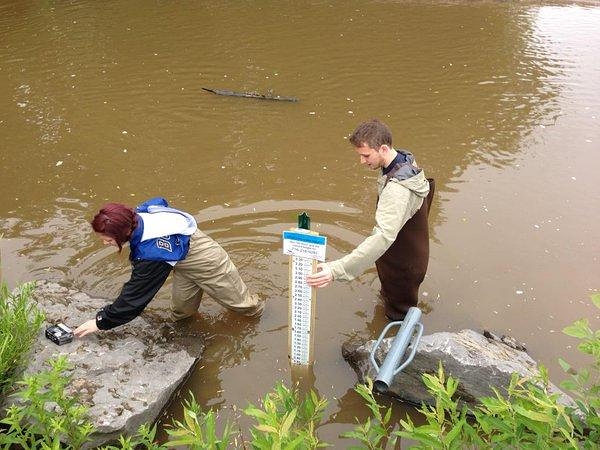
Our Mission
Conserving California wildlife habitat and species through science and education
Our work protecting watersheds, restoring creeks and estuaries, and helping recover iconic California species begins with you. Your support will help make a lasting difference, from Monterey to Ventura.
Our Current Projects
Citizen Science
Crowd hydrology empowers the public to be citizen scientists!

Crowd Hydrology
CLC staff installs signage that measures water depth in various sites throughout the county, along with instructions for how to read water depth and submit data via text message to be automatically added to an online water level graph (http://www.crowdhydrology.com/).This helps our local environmental and water management agencies tremendously! It’s that easy to be a citizen scientist!
Crowd Hydrology was established in 2010 with the goal of using innovative methods to collect spatially distributed hydrologic data. What began in the Northeast United States has now expanded to the entire continent. CLC is a dedicated partner bringing this program to our local watersheds. CLC has installed and maintains the first Crowd Hydrology sites in California. To learn more about this program or to volunteer as a citizen scientist contact info@creeklands.org
Stay Connected
Tune in to learn about Central Coast Conservation and support ecological resilience.
Watershed Plans
 Watershed plans assess the health and wellbeing of waterways, their habitats and inhabitants. We identify water issues and recommend improvements and enhancements. People who live and work within the watershed voluntarily participate, shaping recommendations and in many cases become part of the solution.
Watershed plans assess the health and wellbeing of waterways, their habitats and inhabitants. We identify water issues and recommend improvements and enhancements. People who live and work within the watershed voluntarily participate, shaping recommendations and in many cases become part of the solution.
- A migratory barrier to be modified at the Union Pacific Railroad culvert to pass all life stages of Steelhead trout. The design is complete. Help to implement this project (link).
- Completed instream flow study to augment stream flows in the summer and fall for fish and wildlife. Help us make it happen.
- A migratory barrier to be modified at the Arroyo Grande Creek Stream Gauge to pass all life stages of Steelhead trout. Help implement this project.
Assessed the population of Steelhead downstream of Lopez Dam. See what the report says here. - Currently designing a bridge at Cecchetti Road Crossing to replace the Arizona Crossing which partially blocks fish passage.
- A migratory barrier to be modified in the Under City Culvert at Mission Plaza to pass all life stages of Steelhead trout. Help implement this project.
- Designing modifications to the fish passage barrier at the Marre Weir adjacent to the Bob Jones Trail. Help make it happen.
- In partnership with the City of San Luis Obispo, we are designing a stream enhancement project at the Fox Hollow Reservoir to rehydrate the creek in late summer and early fall. Find out more here.
- In partnership with the California Department of Fish and Wildlife, we are counting fish through the Coastal Monitoring Program. See how this works here.
- Designing stream flow enhancements along the middle reaches for fish and farm water security.
- In partnership with the California Department of Fish and Wildlife, we are counting fish through the Coastal Monitoring Program.
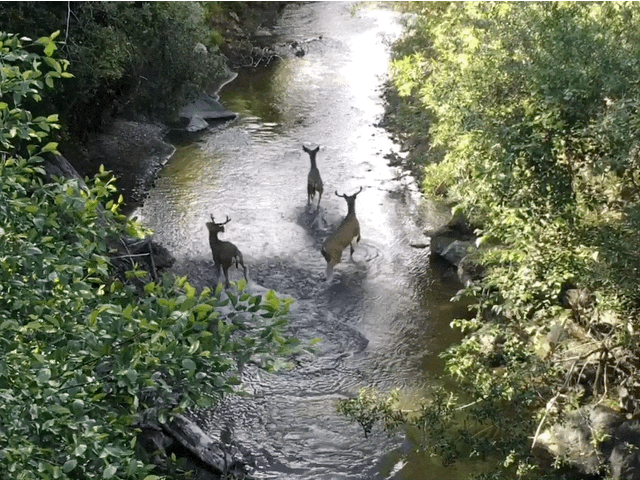
- Developing a watershed plan that covers both San Luis Obispo and Monterey Counties.
- Creating a Steelhead Conceptual Plan for the Salinas River to protect and enhance the population.
- CLC has partnered with Stillwater Sciences, and together we act as the Salinas Watershed Management Coordinator. Our goal is to develop watershed plans for the Salinas River Watershed that will effectively support both this important agricultural region, as well as the critical steelhead habitat that exists there. Some issues that will be addressed include the damming of tributaries, groundwater pumping, sand and gravel mining, and saltwater intrusion at the river’s end in Monterey Bay.
- In partnership with the Carmel River Steelhead Association, we designed and installed large wood debris structures to enhance shelter for migrating Steelhead trout in the Carmel River Lagoon using a helicopter to avoid impacts to habitat.
- In partnership with the Monterey County Resource Conservation District, we completed a watershed management plan to support recovery of threatened Steelhead trout in the watershed. Read it here.
Fish Passage
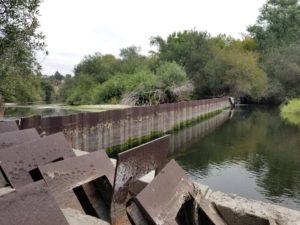 Sometimes fish need to move from one place to another, whether it’s a rainbow trout that needs to find a way to the ocean to become a steelhead, or a lamprey eel that needs to come upstream from the ocean to spawn. When people build structures like dams or weirs, they can block fish migration. Here are some projects to balance the needs of people and nature!
Sometimes fish need to move from one place to another, whether it’s a rainbow trout that needs to find a way to the ocean to become a steelhead, or a lamprey eel that needs to come upstream from the ocean to spawn. When people build structures like dams or weirs, they can block fish migration. Here are some projects to balance the needs of people and nature!
Arroyo Grande Stream Gauge Modification
- This project removes and reconstructs the existing platform that currently spans the main creek channel and lowers the stream bed so migrating steelhead can once again swim upstream to more than three miles of critical habitat. CLC is currently evaluating alternatives at this site in partnership with the county of San Luis Obispo.
Lower San Luis Obispo Creek Fish Passage & Seawater Barrier Study
This project is designed to improve the largest resource for the Southern Central California steelhead from Santa Cruz to Santa Maria. At the south end of San Luis Obispo Creek is the “Marre Weir”, a low dam that extends underground, preventing saltwater from entering the freshwater of the creek. The Marre Weir was built in the 1960’s with only minor modifications since, and in our study we will look at alternatives to improve or replace the existing weir.
Our goals and the long term benefits of this project:
- Improves Water Supply Reliability
By improving the Marre Weir, it ensures the resistance against seawater intrusion to keep the freshwater supply high - Increases Environmental Benefits
This enhances the migration of the Southern Central California Coast Steelhead. This is important because the fish are listed as threatened under the Endangered Species Act. - Improves Groundwater Management
The Marre Weir is essential to protecting the groundwater from being mixed with the seawater. By improving it we can ensure the freshwater stays fresh. - Addresses Climate Change Concerns
The study will evaluate the probable impacts of climate change, focusing on the sea level rise that can impact the Weir. The top notch of the weir is located about one foot above the current high tide line. - Improves Water Resource Management & Outreach
This study will bring local communities together to help determine how to improve the fish passage while keeping the protective benefits to the groundwater and freshwater resources for the present and future years to come.
San Luis Obispo Creek City Culvert Fish Passage Enhancement Project
- San Luis Obispo Creek runs underneath downtown San Luis Obispo, where there are several partial barriers over which adult and juvenile steelhead trout have difficulty migrating. CLC has completed a feasibility study of how modifying the barriers inside the tunnel could improve fish passage, and is currently weighing possible alternatives with partner organizations such as the City of San Luis Obispo.
Possible alternatives include:
- Constructing high-flow by-pass
- Constructing a step-pool channel
- Constructing a low-flow channel
- Doing nothing
California’s Central Coast
The rugged beauty of the Central Coast is beloved by millions around the globe. People also depend on these lands and waters for agriculture and other economic interests. Creek Lands Conservation is dedicated to helping Central Coast communities find sustainable balance between human activities and healthy ecosystems.
Stream Flow Augmentation
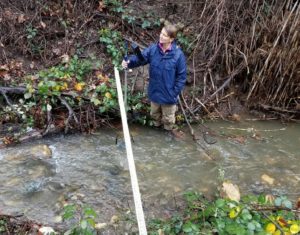 How much water must flow in a creek to support both human activities and the needs of nature? The answer is different for every watershed, and finding it starts with understanding the characteristics of each stream. Check out our innovative science-driven projects to keep enough water in the creek to support wildlife all year long!
How much water must flow in a creek to support both human activities and the needs of nature? The answer is different for every watershed, and finding it starts with understanding the characteristics of each stream. Check out our innovative science-driven projects to keep enough water in the creek to support wildlife all year long!
San Luis Obispo Creek Flow Enhancement
This project is designed to help keep critical aquatic habitats in San Luis Obispo Creek wet during the dry season. This will be done by collecting rainwater and flood waters during the winter that flow out into the Pacific Ocean, storing it, and then releasing it into the Creek in the summer. Collected water will be temporarily stored in a repurposed 1940’s reservoir owned by the City of San Luis Obispo. Water will be released in the summer to maintain critical habitat for juvenile steelhead trout.
Santa Rosa Creek Flow Enhancement
This project takes an integrative approach to improve the amount of water in the ground and in local creeks to support in critical steelhead trout habitat.. Our team is working with seven private agricultural landowners to design stormwater capture, groundwater recharge, and floodplain reconnection projects. These projects will raise both groundwater and creek water levels during the dry season.
Working cooperatively with stakeholders including landowners and other community members, this project takes an integrative approach to improve steelhead habitat by ensuring water is in the creek during the late summer when steelhead need it the most. The team is exploring different approaches including capturing water running over the landscape after it rains (called stormwater)and infiltrating it into the ground via recharge basins. This in turn raises groundwater levels and creek levels during the summer, which is critical for steelhead trout survival in our region. Another method to recharge groundwater is to restore connections between the creek and fallow “dried” creek land or crop fields that don’t mind wet roots in the winter so that flood waters are allowed to once again spread across historic floodplains and infiltrate into the ground. Methods to change the scheduling of groundwater consumption through developing alternative water sources (e.g. water conservation or rainwater capture and storage) are also being explored. Groundwater is vital for people and wildlife. Rainwater recharges groundwater aquifers, and we can help by slowing it, sinking it, and spreading it. Projects like this one help develop best practices that will ensure healthy creeks and groundwater and take sustainable practices to a new level!
Stream Monitoring
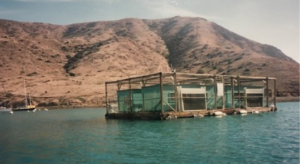 Watershed plans assess the health and wellbeing of waterways, their habitats and inhabitants. We identify water issues and recommend improvements and enhancements. People who live and work within the watershed voluntarily participate, shaping recommendations and in many cases become part of the solution.
Watershed plans assess the health and wellbeing of waterways, their habitats and inhabitants. We identify water issues and recommend improvements and enhancements. People who live and work within the watershed voluntarily participate, shaping recommendations and in many cases become part of the solution.
County Wide Base Flow Monitoring for Stream Flow Enhancement
CreekLands measured the amount of water that flows in our local creeks and rivers throughout San Luis Obispo County for four years (2015-2018). The purpose of this project was to determine if there is enough water in our waterways for steelhead trout and other aquatic species such as frogs, newts, as well as other species of fish. In streams where the water is insufficient we work with partners to improve stream flows using lots of groovy strategies!
The results of our study can be found by clicking on the pink bubbles on this interactive map: http://geo.stillwatersci.com/maps/slo_rifa/instreamflowassessment.html
Creek Lands works with various partners including private landowners, government agencies, and other not for profits to improve instream flows by both leaving more water in the ground and capturing water that otherwise would flow to the Pacific Ocean during floods in the winter and storing it for release in the summer when creek ecosystems are most stressed. Creative solutions that generate more water for people include rainwater capture and storage or grey water reuse, which allows people to use less water from streams and rivers or from groundwater that is hydrologically connected to our local streams and rivers. Creative solutions that capture and store winter flood waters includes groundwater recharge and floodplain reconnection.
Monitoring Micro-Flows and Tracking Ecologically Significant Dry Season Creeks
This study is reviewing flow monitoring and tracking methods utilized by agencies and nonprofits working to measure ‘micro” flows (< 1 cfs). Standard methods of measuring flow (e.g. USGS) have been developed for higher flows than those typically encountered during the dry season on the Central Coast of California. Restoring steelhead habitat at low flows or micro flows requires us to re-evaluate commonly used methods and improve accurate but rapid methods of measurement that can be utilized by a wide range of partners in California.
If you are more interested in this study please contact aleks@creeklands.org
Our Priorities
Restoration Science
We are committed to understanding the unique attributes of Central Coast wildlife habitat, so people can make informed choices about natural resource utilization.
Collaboration
Central Coast restoration, conservation and sustainability challenges are bigger than any one organization can address, so we thrive together with a wide range of partners.
Get Engaged
Effective ecosystem stewardship requires good understanding, and deep connections. When people get outside and learn how nature works they want to be involved with environmental care.

